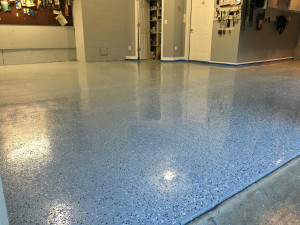How Garage Floor Epoxy Creates a Brighter Cleaner Work Space
 There are many reasons to like garage floor epoxy coatings whether you are trying to make your garage look better, protect your concrete slab or if you’re trying to increase functionality. Before we get into that, let’s talk about your garage. Let’s face it, you can put a lot of work into your garage to make sure that it is the ultimate workspace. Even simple things like making sure your garage doors work will help you have the ultimate workspace, you don’t want to struggle to bring in cars if your doors don’t work properly. If something like this happens, then you can easily call up something like these Crofton Maryland Garage door repair professionals to help get this fixed for you. You don’t want there to be any issue when it comes to your garage, particularly if you are working in there constantly. Maybe you’re working on restoring a classic car, maybe it’s a woodshop, or maybe it’s just a general workshop – there are many different reasons to use a garage as your workshop, and we would be hard-pressed to list every single one of them here. If you are using your garage to store your collection of classic cars, you may want to consider professional auto transport to move them between your properties or to and from auto shows. The one thing that all workshops have in common, however, is that they need a high-quality floor, which can contribute in more ways than one. Sure, a garage floor epoxy solution makes for a very durable surface, but most people think the benefits end there. Don’t worry, you definitely get more bang for your buck than you think.
There are many reasons to like garage floor epoxy coatings whether you are trying to make your garage look better, protect your concrete slab or if you’re trying to increase functionality. Before we get into that, let’s talk about your garage. Let’s face it, you can put a lot of work into your garage to make sure that it is the ultimate workspace. Even simple things like making sure your garage doors work will help you have the ultimate workspace, you don’t want to struggle to bring in cars if your doors don’t work properly. If something like this happens, then you can easily call up something like these Crofton Maryland Garage door repair professionals to help get this fixed for you. You don’t want there to be any issue when it comes to your garage, particularly if you are working in there constantly. Maybe you’re working on restoring a classic car, maybe it’s a woodshop, or maybe it’s just a general workshop – there are many different reasons to use a garage as your workshop, and we would be hard-pressed to list every single one of them here. If you are using your garage to store your collection of classic cars, you may want to consider professional auto transport to move them between your properties or to and from auto shows. The one thing that all workshops have in common, however, is that they need a high-quality floor, which can contribute in more ways than one. Sure, a garage floor epoxy solution makes for a very durable surface, but most people think the benefits end there. Don’t worry, you definitely get more bang for your buck than you think.
A Cleaner Work Space
It’s a workshop; mistakes are bound to happen, whether you spill a cup of coffee or tip over a drum of industrial grade corrosive material. On a typical garage floor, both of these would present a serious problem; coffee would stain the concrete, and the corrosive, well, we don’t even want to discuss what that would do. This is where floor epoxy has the advantage – it might require a bit of an investment but it’s well worth the cost. Here there are two different benefits. First of all, epoxy is very durable, but you should also consider that it is stain resistant. It does a great job of closing the pores that would otherwise rather easily absorb and accept any number of materials. Instead of permitting damage or even a stain, the chemicals will remain on the surface, allowing you to clean them at your leisure. Protecting your floor from staining and corrosion plus having dramatic porcelain-like finish a great reason to consider ArmorGarage epoxy coatings.
In addition to the above it is far easier to clean. You can use a simple washrag or a bucket of soapy water to get your epoxy floor back to its original shine, and it really doesn’t take that much effort on your part. That being said, not only does it reduce the mess, it also takes the effort out of cleaning. You were, after all, planning to expend your effort on other, more important things, weren’t you?
One of the better side effects of being able to keep a clean work space is the ability to get rid of most germs and allergens. If you suffer from allergies or simply want to prevent illness, these flooring options are not only outstanding, they are completely mold and mildew proof. You will keep your work space clean, you will ensure there are no nasty allergens or airborne illnesses wandering around your shop or garage. It doesn’t get much better than that – unless you consider how much brighter your workshop will be.
A Brighter Workspace
 What many people fail to consider is how much brighter garage floor epoxy will make their work space. You will find that one of the many benefits is the floor’s ability to make your work space brighter. If you use standard fluorescent lights, you will discover that they reflect well off of your high gloss epoxy floor, making for a much brighter space. Not only is this aesthetically pleasing, it will be a great way to conserve on energy that you might have otherwise wasted in lighting. In the end, you’re going to save on energy you’re going to have a slip resistant surface, and most importantly you’re going to have a garage/shop that you can be proud of. It doesn’t get much better than that. Well, as long as your garage is clean, of course. If you’re investing in epoxy flooring, you may as well also invest in cleaning out your garage to make the place look spotless. It’s likely a lot of rubbish and useless items you no longer need have gathered in your garage; it’s useful to look into dumpster rental service in Kansas City MO if this is the case. Get that garage looking as good as new!
What many people fail to consider is how much brighter garage floor epoxy will make their work space. You will find that one of the many benefits is the floor’s ability to make your work space brighter. If you use standard fluorescent lights, you will discover that they reflect well off of your high gloss epoxy floor, making for a much brighter space. Not only is this aesthetically pleasing, it will be a great way to conserve on energy that you might have otherwise wasted in lighting. In the end, you’re going to save on energy you’re going to have a slip resistant surface, and most importantly you’re going to have a garage/shop that you can be proud of. It doesn’t get much better than that. Well, as long as your garage is clean, of course. If you’re investing in epoxy flooring, you may as well also invest in cleaning out your garage to make the place look spotless. It’s likely a lot of rubbish and useless items you no longer need have gathered in your garage; it’s useful to look into dumpster rental service in Kansas City MO if this is the case. Get that garage looking as good as new!
Take a look at the garage flooring prices today and get ready to give your work space the treatment it deserves. Installation is easy and lasts for up to twenty years.


 There are many mistakes that can be made during the installation of garage epoxy flooring as we are sure you are aware, but we have cut it down to just a few for the sake of expedience.
There are many mistakes that can be made during the installation of garage epoxy flooring as we are sure you are aware, but we have cut it down to just a few for the sake of expedience.


